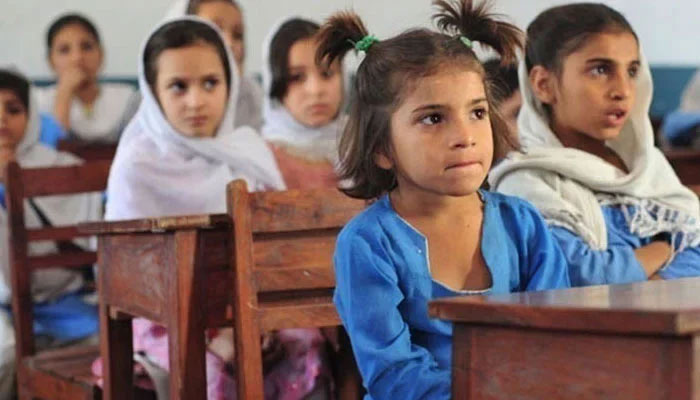Children come first
The global rise in temperature as compared to the 19th century has contributed to a chain reaction in weather events
Climate change challenges are unprecedented across the world, affecting every region equally regardless of contribution to global warming.
As human activities keep changing the planetary environment day by day, floods, droughts, wildfires, heatwaves, extreme cold, and high or low rainfall have become a constant part of weather that impacts not only the entire ecosystem but also the food, health and education sectors.
The global rise in temperature as compared to the 19th century has contributed to a chain reaction in weather events that led to low crop production, disruption in the water and food supply chains, and a subsequent increase in inflation and economic demand of society.
Climate volatility has changed the fate of many and proves fatal for 1.7 million children under five years across the world annually. However, global conflicts and wars are equally aggravating the situation of health, food insecurity and education.
The long-term effects of environmental determinants of health on the young are multifaceted; children are more susceptible to polluted air, humidity, extreme temperatures and malnutrition. According to the latest research by Save the Children, children’s rights to basic healthcare, food, environment and education are affected to such an extent that the new generation that came to this world last year will appear to fight on average 2-7 times more weather hazards as compared to their ancestors.
Climate change is a serious threat. According to the Global Climate Index, Pakistan is ranked the fifth most vulnerable country to severe weather conditions and global warming. However, its contribution to climatic change (GHG emission) is only one per cent.
As Pakistan continues to grow in population and urbanization, these climatic shocks are getting more detrimental. According to Unicef’s Children Climate Risk Index (CCRI) 2021, South Asian children, including Pakistan, are at an extremely high risk due to climate change.
After the 2022 floods in Pakistan, more than 800,000 children were affected by climate change due to the unbearable heat in June 2023. It is catastrophic for the little ones since they are sensitive to heat and cannot adjust quickly to high-temperature variations like adults.
Constant increases in global temperatures are altering precipitation patterns as well as shifting the monsoon season, impacting agriculture. The rain-fed agriculture that depends on weather conditions fulfills the food consumption of around 60 per cent of the Pakistani population.
Crops like sugarcane, wheat, rice, maize and cotton are affected by climate change, and the World Bank report 2021 has warned that these crops will further decrease in yield in the coming decade. Pakistan’s 38 million population is already under moderate to extreme hunger. A World Bank report also says that more than 40 per cent of children under five are still stunted – while in Sindh it is 66 per cent – impacting children’s mental and physical growth.
Extreme weather conditions also make safe water access difficult due to water shortages and adulteration. Water is life; it plays an important role in preventing the spread of infectious diseases by maintaining hygiene and sanitation. According to a Unicef report, 347 million South Asian children are facing high or extremely high water scarcity due to low rainfall.
Floods and heavy rainfall leave water reservoirs contaminated, which become a source of food and vector-borne diseases. One of the keys to developing resilience to counter infectious disease outbreaks due to climate crisis is safe storage and hygienic access to water and sanitation.
The impact of climate can also be seen in the unequal socioeconomic status of rural and urban societies among health facilities, food insecurity and education systems. Natural disasters due to climate change disrupt the educational system for children, affecting their psychological health.
Long school closures due to floods, rain or smog are increasing, which hinder academic progress and learning abilities. In 2022 about 26,600 schools were destroyed due to floods, affecting 3.5 million children. Its effects can still be seen, as Unesco 2023 reports that about 22.8 million children aged 5–16 years are still out of school. All these schools need to be upgraded with climate-proof construction on an urgent basis.
Shaping infrastructure for a climate-resilient future by taking effective emergency preparedness measures by the government to organize, respond and rebuild is now imperative. It will protect the rights of the new generation of society and empower marginalized communities with resources, minimizing further negative impacts of climate occurrences.
Technologies in agriculture and healthcare systems that are climate-smart are important for a more economically and environmentally sustainable food and health system.
There is a need to work across sectors to mitigate and adapt to the changing climate while supporting nutrition, health, water, sanitation, education and a sustainable atmosphere for children who are under the constant threat of climate change.
The writer is a registered dietitian and nutritionist. She can be reached at: tabinda08@gmail.com
-
 Chevy Chase Shares Disappointment After 'SNL50: The Anniversary Special' Snub
Chevy Chase Shares Disappointment After 'SNL50: The Anniversary Special' Snub -
 Samuel L. Jackson's Old Movie Found New Life: Here's How
Samuel L. Jackson's Old Movie Found New Life: Here's How -
 Nobel Prize Snub Hardens Donald Trump's Tone On ‘peace’
Nobel Prize Snub Hardens Donald Trump's Tone On ‘peace’ -
 What's Prince Harry's Case Against The Daily Mail's Publisher?
What's Prince Harry's Case Against The Daily Mail's Publisher? -
 'Matilda' Star Mara Wilson Breaks Silence On AI's 'deepfake Apocalypse' After Being Abused
'Matilda' Star Mara Wilson Breaks Silence On AI's 'deepfake Apocalypse' After Being Abused -
 Meghan Markle 'ruined' Prince Harry's Life?
Meghan Markle 'ruined' Prince Harry's Life? -
 Super Bowl Halftime Show Gets Another Attraction Besides Bad Bunny
Super Bowl Halftime Show Gets Another Attraction Besides Bad Bunny -
 Princess Irene's Coffin Arrives For Funeral Rites
Princess Irene's Coffin Arrives For Funeral Rites -
 Sean Penn's Gay Role Interview Resurfaces After LA Stroll With Valeria Nicov
Sean Penn's Gay Role Interview Resurfaces After LA Stroll With Valeria Nicov -
 FBI’s Most Wanted Caught After 10 Years In Mexico
FBI’s Most Wanted Caught After 10 Years In Mexico -
 Inside Kate Middleton's Meaningful Nod To Own Milestone
Inside Kate Middleton's Meaningful Nod To Own Milestone -
 Zachary Levi 'running' To Build His Future In Politics?
Zachary Levi 'running' To Build His Future In Politics? -
 Andrew Lands In Fresh Major Trouble After Princess Eugenie Left Him 'devastated'
Andrew Lands In Fresh Major Trouble After Princess Eugenie Left Him 'devastated' -
 Colleen Hoover Shares Major Update About Cancer Treatment
Colleen Hoover Shares Major Update About Cancer Treatment -
 UK Starmer Rules Out US Trade War, Calls For ‘calm Diplomacy’ Over Greenland
UK Starmer Rules Out US Trade War, Calls For ‘calm Diplomacy’ Over Greenland -
 Billy Bob Thornton Clears The Air About His Exit From 'Landman'
Billy Bob Thornton Clears The Air About His Exit From 'Landman'




